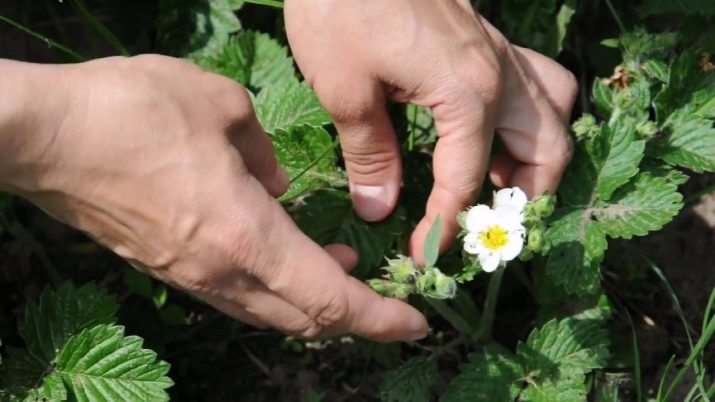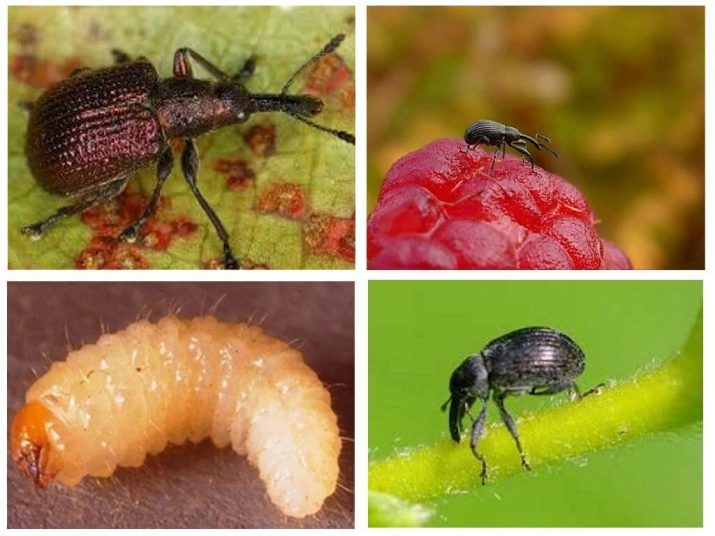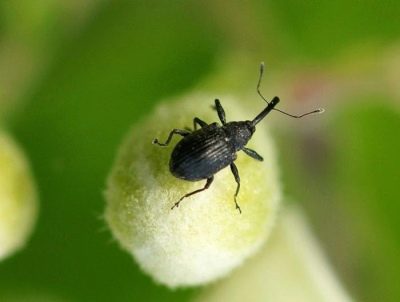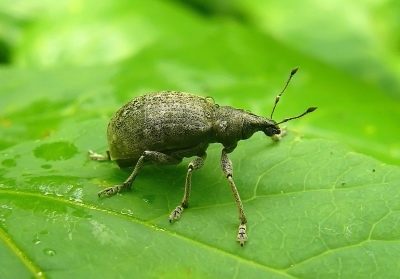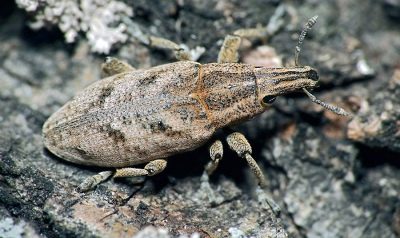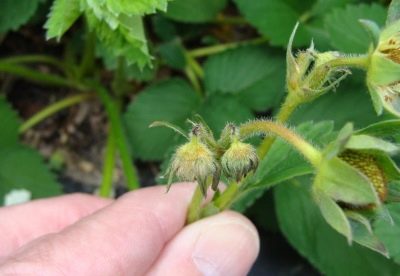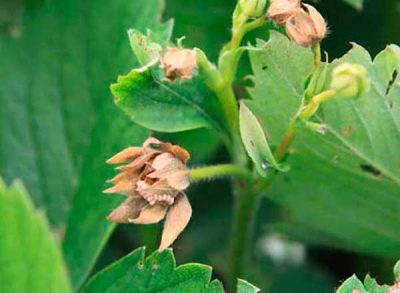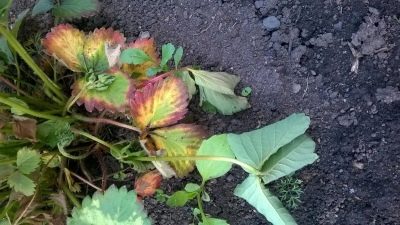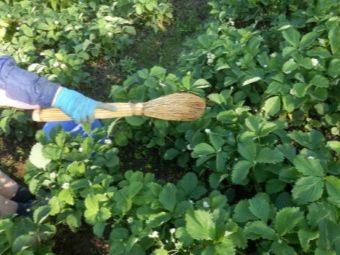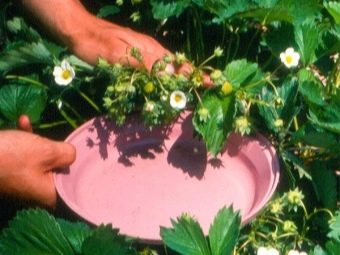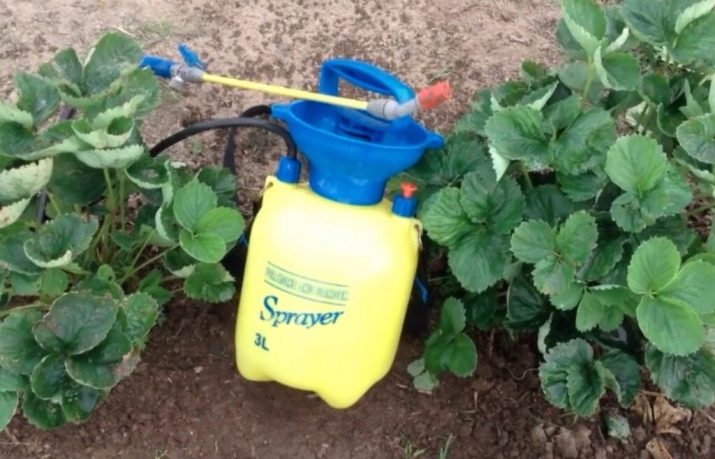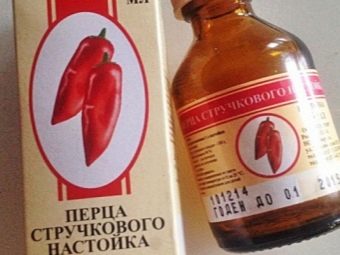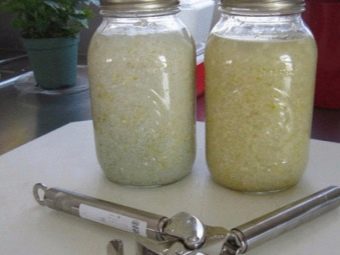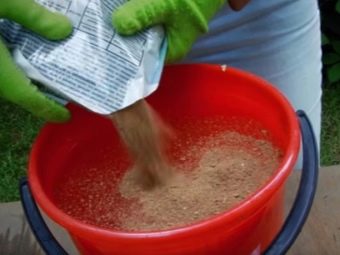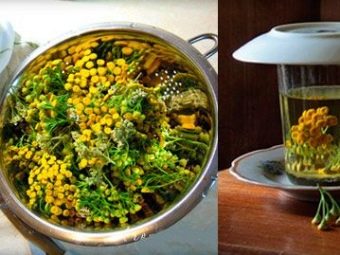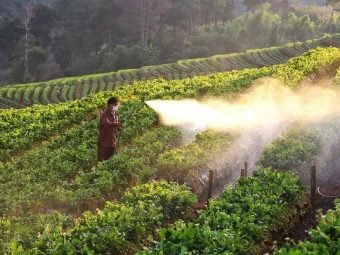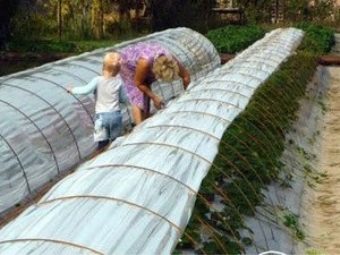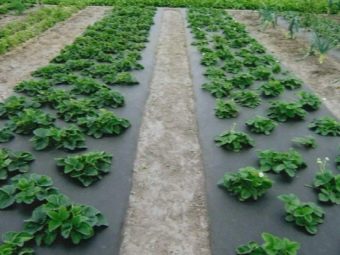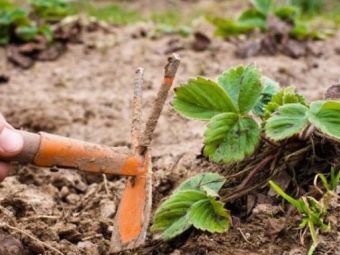How to deal with weevil on strawberries?

Even with the proper planting of strawberries and with proper care for it, dangerous pests can interfere with obtaining a quality crop. To prevent this, you should carefully familiarize yourself with possible threats and take the necessary measures.
For a berry such as strawberry, the greatest danger is the weevil beetle, which will be discussed.
Pest description
This beetle is a representative of the huge family Curculionidae, containing more than 60 thousand species of completely different beetles.
The main sign of the weevil is a long proboscis, resembling elephant.
Females of this family lay their eggs mainly in the roots, leaves or stalks of the plant. In these places, further growth of the larvae feeding on the insides of the plant occurs. Next, the pupation process occurs. Upon completion of this process, the adult insect leaves the already nearly destroyed plant.
The most dangerous include the following types of weevils.
Raspberry-strawberry
Such an insect has an oval body shape with a black color and a long nose. There are also small blond hairs on the entire surface of the body. This beetle is widely distributed in Siberia and Altai. Its size can reach three millimeters. A huge danger of this type may be in such plants as: raspberry, blackberry, dogrose and many others.
It causes the greatest harm to the leaves, stalks and ovaries. Winter insect spends next to the plant - in the soil. Activity begins in May, and ends in June.
Rough
This is a gray beetle with an oval body shape and about seven millimeters in size. On its nape there are small hairs and small scales. The "proboscis" is short, forming "lobes" in the antennae. Widely distributed almost worldwide. The larva of the beetle feeds on the roots, and the adult individuals feed on the buds of the berry crops.
Most activity occurs during rain.
An interesting fact is that if you touch an insect, it pretends to be dead.
Small black
This omnivorous pest is found only in the European part of Russia. He gives the greatest preference to beetroot, berry crops, and also coniferous plants. Its larvae are able to completely destroy the root system, leaving no living space on it. The length of such a weevil is no more than five millimeters. It looks very typical, its body is oval-shaped and dark in color, and there are small bright specks all over its area.
There is a wide, but very short trunk. Paws and whiskers have a burgundy shade.
The activity of the insect manifests only at dusk, and during the day it carefully hides.
Alfalfa
This beetle is considered one of the largest in this family. Its size reaches twelve millimeters. The shape of the body is ovoid, and the color is dark. The beetle's nose is short, but rather wide. It is worth noting that the color of the calf can vary. There are beetles of gray, black, and even yellowish. You can find such an insect in the European part of Russia, as well as in the region of the Caucasus and Southern Siberia. It feeds mainly on herbaceous plants. Special preference is given to hops, legumes, and fruit and berry crops.
Adults feed on leaves, flowers and buds, and the larvae only on roots. Activity falls from May to July in the morning and in the evening.
Furrowed
This omnivorous pest eats mainly berry, technical, vegetable and even ornamental crops. Adult insects prefer their leaves and buds, but the larvae prefer roots. Body color is black or brown, it also has a spotted pattern. The nose of the beetle is short, having a small groove. Its length can vary from eight to ten millimeters. They live mainly in greenhouses or greenhouses.
Signs of appearance
Usually, even the most experienced gardeners are not able to detect the weevil when it first appears.This is very bad, since such an insect is able to destroy the plant in a very short time.
Weevils appear on the strawberry quite imperceptibly, however, the consequences of their appearance is simply impossible to overlook. These include shedding of buds, withering of seedlings, and the death of ovaries, and much more. To prevent such unpleasant consequences, you should carefully examine all possible signs of the appearance of weevil on strawberries.
When searching for such an insect, it is very important to know that Search for individual representatives will not bring much success. A lonelyuk is not able to pose a great threat to the garden, but the colonies are very likely.
The search greatly facilitates the fact that weevils are not adapted to flight, due to the fact that many have no wings. That is why they move exclusively by crawling.
Starting the search is best in autumn or spring. When inspecting strawberry bushes, you should pay special attention to the following signs.
Holes on the leaves
Such holes are more like punctures that weevils make with the help of their “proboscis”. With a small number of beetles on the site, such traces of damage will be significantly less.
Withering stalks or pedicels
Such marks are very similar to those that remain after cutting with scissors. Particular attention should be paid to the presence of damaged peduncles. In this case, we can conclude that a raspberry-strawberry weevil has started in the garden.
Shrunken edges of leaves
The dried edges of the leaves are a clear fact of the presence of a stem or leaf elephant on the site.
Dried bushes or rosettes
Inspection should be carried out directly at the roots. Circular damage indicates the presence of a scythe.
It should also be aware that next to a plant that has at least one of the above signs, there must be adult beetles or their larvae.
The consequences of such insects can be catastrophic. If you do not pay attention to all signs of the appearance of weevil, beetles can breed so that it will be almost impossible to get rid of them.
These bugs can destroy most of the crop, affecting not only strawberries, but also other crops.
Having caused harm to one summer resident, they immediately move to the next, so they should be fought immediately.
Special preparations
To combat the weevil, there are the following methods.
- Agrotechnical. This method includes loosening the soil, isolation of affected plants, crop rotation and much more.
- Biological. Such a method implies the use of insecticides or the attraction of weevil enemies to the garden - ants, birds and others.
- Chemical. It will require preparations of inorganic origin or tillage.
- Mechanical. Collection and manual pest control.
It is important to know that one method for complete destruction will not be enough, since the beetles are different, and not everyone will suit a particular method.
However, the most reliable and effective way of combating is considered chemical. He copes well not only with weevils, but also with other dangerous pests.
The most common and available drugs are: Fitoverm, Karbofos, Intavir, Iskrabio, Akarin and many others.
It is also necessary to know the suitable time for treatment, because it also plays an important role.
Weevils spend the winter under the bushes of the plant, and they begin to emerge from hibernation with the advent of heat. This usually occurs during the opening of the buds.
The fight should be premature. Spray the plant must be three to four times. The very first spraying should occur at a time when the buds are not yet isolated. And the second only in early June.
To poison the beetles on strawberries and treat it can only be after the snow comes down.
Folk remedies
Often, experienced gardeners prefer folk drugs to chemicals.This is due to their availability and ease of use. They are also safe for humans and very easy to wash off after treatment.
However, the effect of them is not the same as from chemicals. In addition, the number of treatments with them should be more.
For spring processing, there are the following recipes.
- As a means used during the formation of buds, you can use garlic or tobacco infusion. For the preparation of garlic infusion should be two hundred grams of garlic diluted in ten liters of water.
- There is also a pepper and pepper infusion. Here it is necessary to dilute five hundred grams of such pepper in ten liters of plain water.
- In order to bring weevil, you can use the infusion of celandine and onion peel. The proportions of this drug are one to one. They need to spray only the strawberries that are at the flowering stage.
- For use during the formation of buds, you can use a decoction of tansy or wormwood.
- Solutions of boric acid, as well as potassium permanganate, ammonia and iodine are also considered popular.
- Recently, another rather unusual recipe has been invented to save the plant from harmful insects, namely, tooth powder. It should only sprinkle them with strawberries during its fruiting. It will be particularly relevant in order to process the variety Victoria.
- You can hold and sprinkle mustard. It is required to take a three-liter jar and dilute 0.1 kilogram of powder in it.
- Another reliable, but far from chemical method is the following: it is only necessary to cover the strawberries with plastic wrap. This should be done before the first frost and leave until the heat. The average temperature under such a film is forty degrees and above. After this treatment, you should only remove the film and remove the dead beetles.
The greatest results can be achieved by mulching with ash or dried needles. In springtime, iodine solution treatment or spraying bushes with mustard powder is perfect.
Prevention
In order not to face a long and difficult struggle against the weevil, care should be taken about the preventive measures available to absolutely every modern gardener. To protect your plant in spring and autumn, you just need to follow the following agrotechnical rules:
- it is necessary to regularly carry out thorough weeding and removal of outdated tops;
- should carefully follow all established rules for growing strawberries or strawberries;
- the deepest tillage of the soil in the autumn period is also important - it will be a reliable protection for the plant;
- we should not forget about the timely update of all the beds on the site, as well as their mulching;
- it is better to place strawberry beds as far as possible from other plants where pests are possible;
- you can plant strawberries near onions or garlic - these plants are able to scare the beetle beetle for a long time.
When fighting and preventing this bug, one should not forget about other, no less dangerous pests. To prevent such insects from appearing in the garden, one should carefully and carefully observe all the established agrotechnical rules, as well as love and care for your plant, and then it will bestow its owner with a huge and tasty harvest.
About methods of dealing with weevil on strawberries and prevention, see the next video.

